SUZUKI SX4 2006 1.G Service Workshop Manual
Manufacturer: SUZUKI, Model Year: 2006, Model line: SX4, Model: SUZUKI SX4 2006 1.GPages: 1556, PDF Size: 37.31 MB
Page 581 of 1556
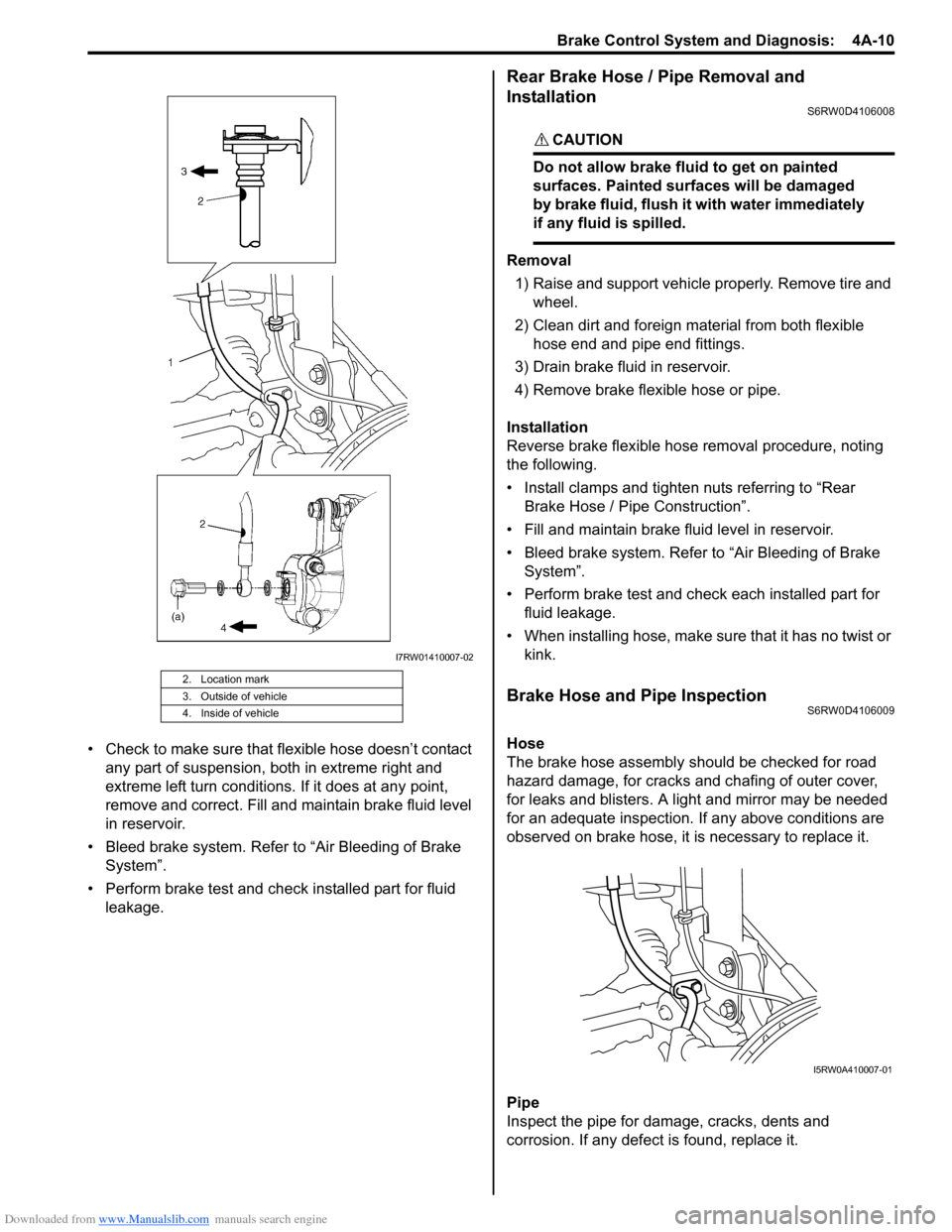
Downloaded from www.Manualslib.com manuals search engine Brake Control System and Diagnosis: 4A-10
• Check to make sure that flexible hose doesn’t contact
any part of suspension, both in extreme right and
extreme left turn conditions. If it does at any point,
remove and correct. Fill and maintain brake fluid level
in reservoir.
• Bleed brake system. Refer to “Air Bleeding of Brake
System”.
• Perform brake test and check installed part for fluid
leakage.
Rear Brake Hose / Pipe Removal and
Installation
S6RW0D4106008
CAUTION!
Do not allow brake fluid to get on painted
surfaces. Painted surfaces will be damaged
by brake fluid, flush it with water immediately
if any fluid is spilled.
Removal
1) Raise and support vehicle properly. Remove tire and
wheel.
2) Clean dirt and foreign material from both flexible
hose end and pipe end fittings.
3) Drain brake fluid in reservoir.
4) Remove brake flexible hose or pipe.
Installation
Reverse brake flexible hose removal procedure, noting
the following.
• Install clamps and tighten nuts referring to “Rear
Brake Hose / Pipe Construction”.
• Fill and maintain brake fluid level in reservoir.
• Bleed brake system. Refer to “Air Bleeding of Brake
System”.
• Perform brake test and check each installed part for
fluid leakage.
• When installing hose, make sure that it has no twist or
kink.
Brake Hose and Pipe InspectionS6RW0D4106009
Hose
The brake hose assembly should be checked for road
hazard damage, for cracks and chafing of outer cover,
for leaks and blisters. A light and mirror may be needed
for an adequate inspection. If any above conditions are
observed on brake hose, it is necessary to replace it.
Pipe
Inspect the pipe for damage, cracks, dents and
corrosion. If any defect is found, replace it.
2. Location mark
3. Outside of vehicle
4. Inside of vehicle
I7RW01410007-02
I5RW0A410007-01
Page 582 of 1556
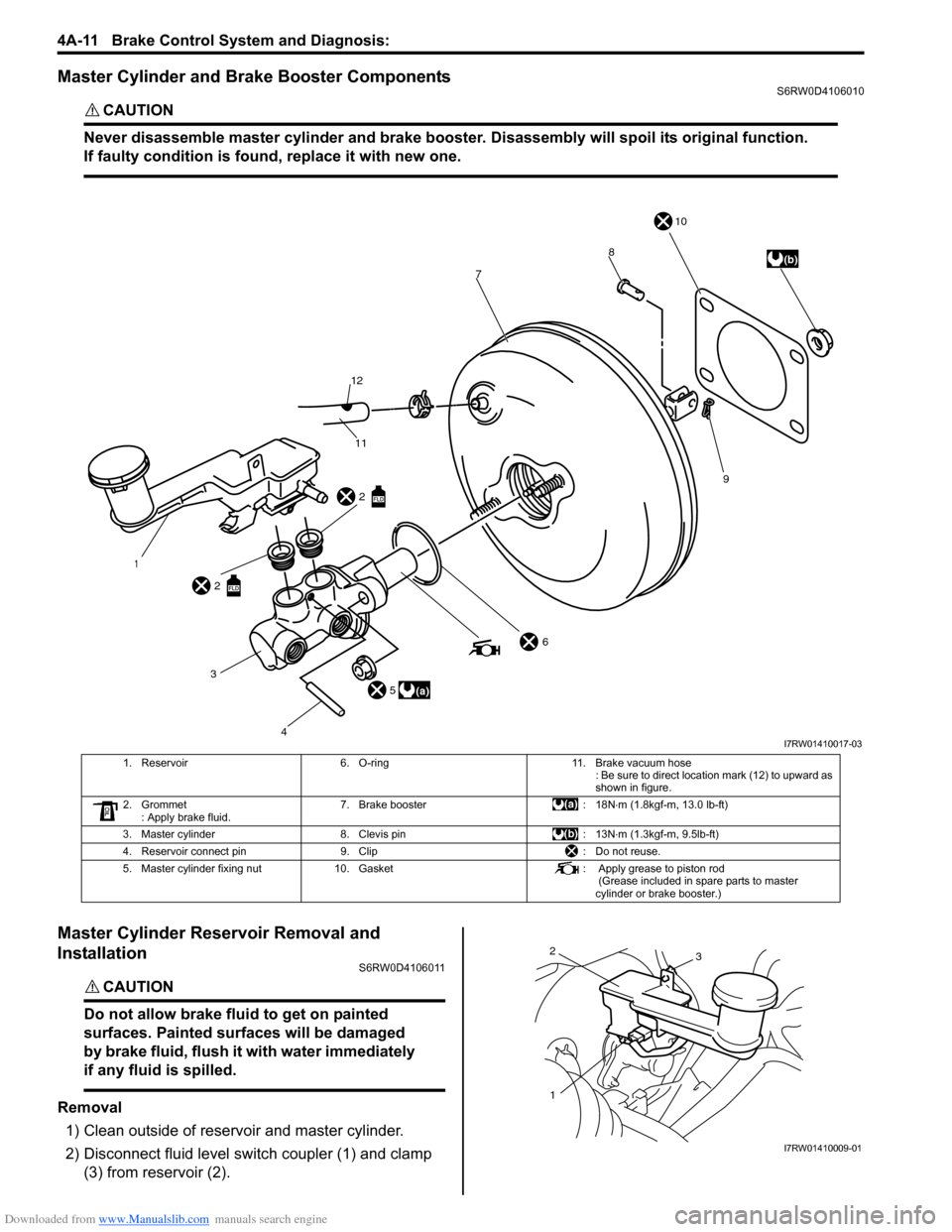
Downloaded from www.Manualslib.com manuals search engine 4A-11 Brake Control System and Diagnosis:
Master Cylinder and Brake Booster ComponentsS6RW0D4106010
CAUTION!
Never disassemble master cylinder and brake booster. Disassembly will spoil its original function.
If faulty condition is found, replace it with new one.
Master Cylinder Reservoir Removal and
Installation
S6RW0D4106011
CAUTION!
Do not allow brake fluid to get on painted
surfaces. Painted surfaces will be damaged
by brake fluid, flush it with water immediately
if any fluid is spilled.
Removal
1) Clean outside of reservoir and master cylinder.
2) Disconnect fluid level switch coupler (1) and clamp
(3) from reservoir (2).
4 2
2
1
(b) 10
9 8
7
11 12
6
3
5(a)
I7RW01410017-03
1. Reservoir 6. O-ring 11. Brake vacuum hose
: Be sure to direct location mark (12) to upward as
shown in figure.
2. Grommet
: Apply brake fluid. 7. Brake booster : 18N⋅m (1.8kgf-m, 13.0 lb-ft)
3. Master cylinder 8. Clevis pin : 13N⋅m (1.3kgf-m, 9.5lb-ft)
4. Reservoir connect pin 9. Clip : Do not reuse.
5. Master cylinder fixing nut 10. Gasket : Apply grease to piston rod
(Grease included in spare parts to master
cylinder or brake booster.)
2
13
I7RW01410009-01
Page 583 of 1556
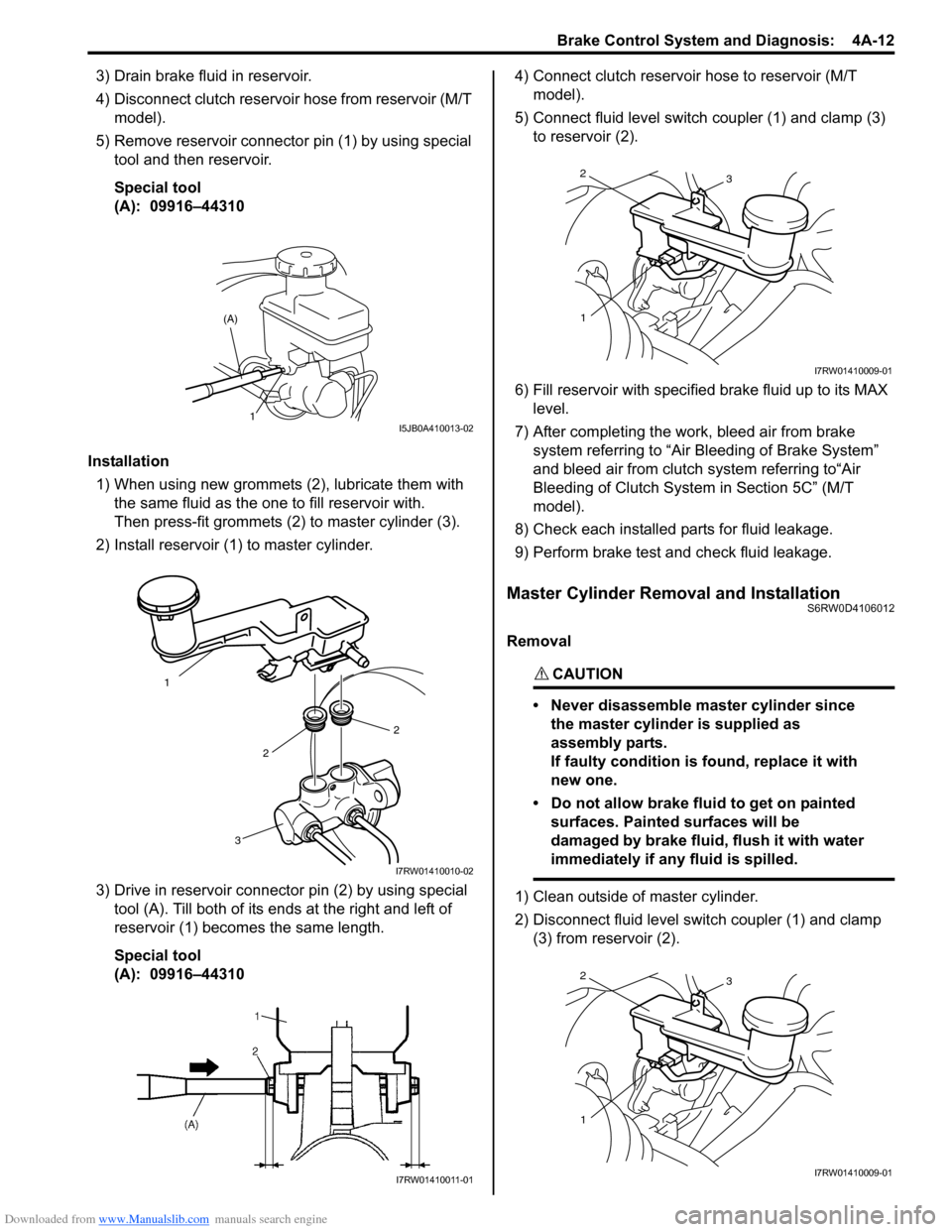
Downloaded from www.Manualslib.com manuals search engine Brake Control System and Diagnosis: 4A-12
3) Drain brake fluid in reservoir.
4) Disconnect clutch reservoir hose from reservoir (M/T
model).
5) Remove reservoir connector pin (1) by using special
tool and then reservoir.
Special tool
(A): 09916–44310
Installation
1) When using new grommets (2), lubricate them with
the same fluid as the one to fill reservoir with.
Then press-fit grommets (2) to master cylinder (3).
2) Install reservoir (1) to master cylinder.
3) Drive in reservoir connector pin (2) by using special
tool (A). Till both of its ends at the right and left of
reservoir (1) becomes the same length.
Special tool
(A): 09916–44310 4) Connect clutch reservoir hose to reservoir (M/T
model).
5) Connect fluid level switch coupler (1) and clamp (3)
to reservoir (2).
6) Fill reservoir with specified brake fluid up to its MAX
level.
7) After completing the work, bleed air from brake
system referring to “Air Bleeding of Brake System”
and bleed air from clutch system referring to“Air
Bleeding of Clutch System in Section 5C” (M/T
model).
8) Check each installed parts for fluid leakage.
9) Perform brake test and check fluid leakage.
Master Cylinder Removal and InstallationS6RW0D4106012
Removal
CAUTION!
• Never disassemble master cylinder since
the master cylinder is supplied as
assembly parts.
If faulty condition is found, replace it with
new one.
• Do not allow brake fluid to get on painted
surfaces. Painted surfaces will be
damaged by brake fluid, flush it with water
immediately if any fluid is spilled.
1) Clean outside of master cylinder.
2) Disconnect fluid level switch coupler (1) and clamp
(3) from reservoir (2).
1 (A)I5JB0A410013-02
1
2
2
3
I7RW01410010-02
I7RW01410011-01
2
13
I7RW01410009-01
2
13
I7RW01410009-01
Page 584 of 1556
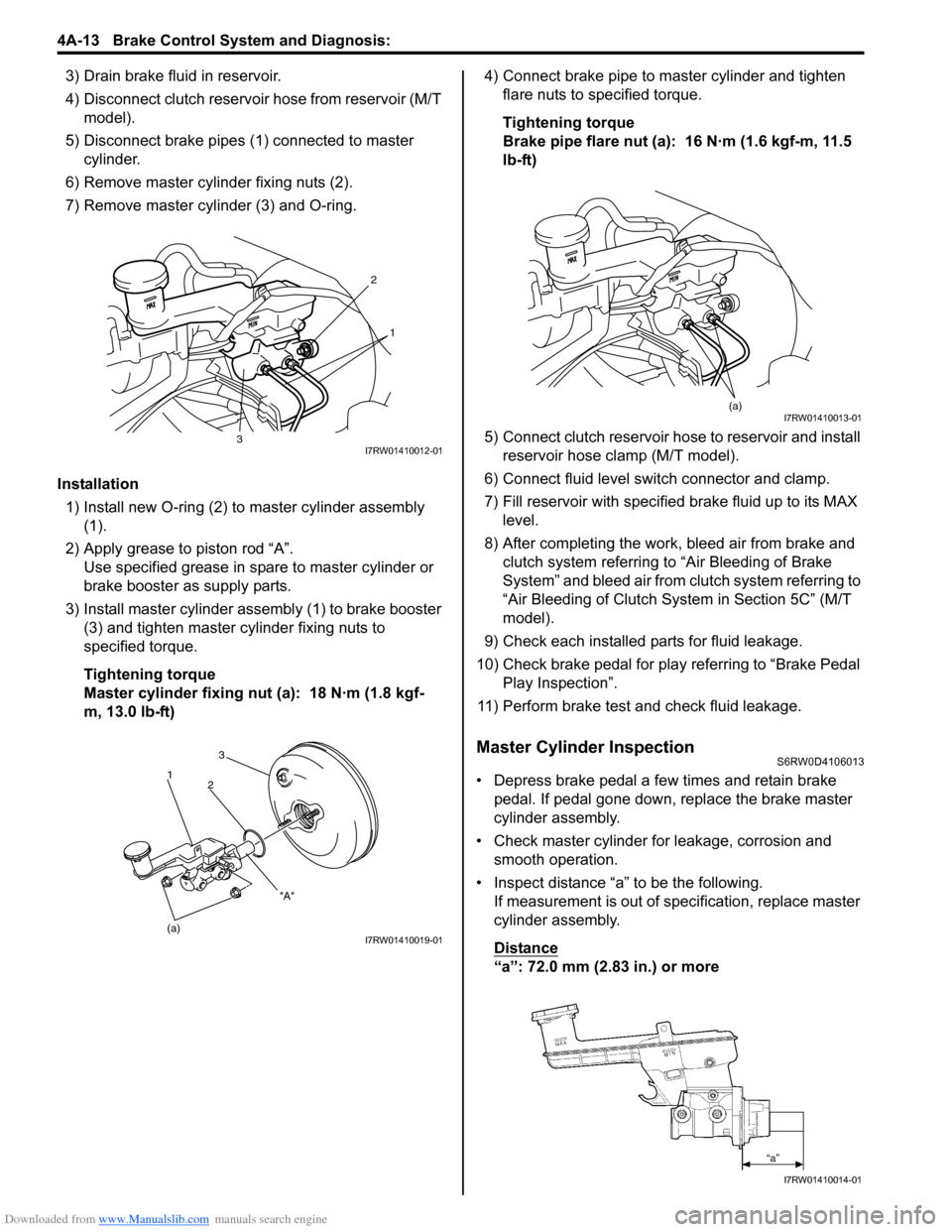
Downloaded from www.Manualslib.com manuals search engine 4A-13 Brake Control System and Diagnosis:
3) Drain brake fluid in reservoir.
4) Disconnect clutch reservoir hose from reservoir (M/T
model).
5) Disconnect brake pipes (1) connected to master
cylinder.
6) Remove master cylinder fixing nuts (2).
7) Remove master cylinder (3) and O-ring.
Installation
1) Install new O-ring (2) to master cylinder assembly
(1).
2) Apply grease to piston rod “A”.
Use specified grease in spare to master cylinder or
brake booster as supply parts.
3) Install master cylinder assembly (1) to brake booster
(3) and tighten master cylinder fixing nuts to
specified torque.
Tightening torque
Master cylinder fixing nut (a): 18 N·m (1.8 kgf-
m, 13.0 lb-ft)4) Connect brake pipe to master cylinder and tighten
flare nuts to specified torque.
Tightening torque
Brake pipe flare nut (a): 16 N·m (1.6 kgf-m, 11.5
lb-ft)
5) Connect clutch reservoir hose to reservoir and install
reservoir hose clamp (M/T model).
6) Connect fluid level switch connector and clamp.
7) Fill reservoir with specified brake fluid up to its MAX
level.
8) After completing the work, bleed air from brake and
clutch system referring to “Air Bleeding of Brake
System” and bleed air from clutch system referring to
“Air Bleeding of Clutch System in Section 5C” (M/T
model).
9) Check each installed parts for fluid leakage.
10) Check brake pedal for play referring to “Brake Pedal
Play Inspection”.
11) Perform brake test and check fluid leakage.
Master Cylinder InspectionS6RW0D4106013
• Depress brake pedal a few times and retain brake
pedal. If pedal gone down, replace the brake master
cylinder assembly.
• Check master cylinder for leakage, corrosion and
smooth operation.
• Inspect distance “a” to be the following.
If measurement is out of specification, replace master
cylinder assembly.
Distance
“a”: 72.0 mm (2.83 in.) or more
2
1
3I7RW01410012-01
(a)3
2
1
"A"
I7RW01410019-01
(a)I7RW01410013-01
I7RW01410014-01
Page 585 of 1556
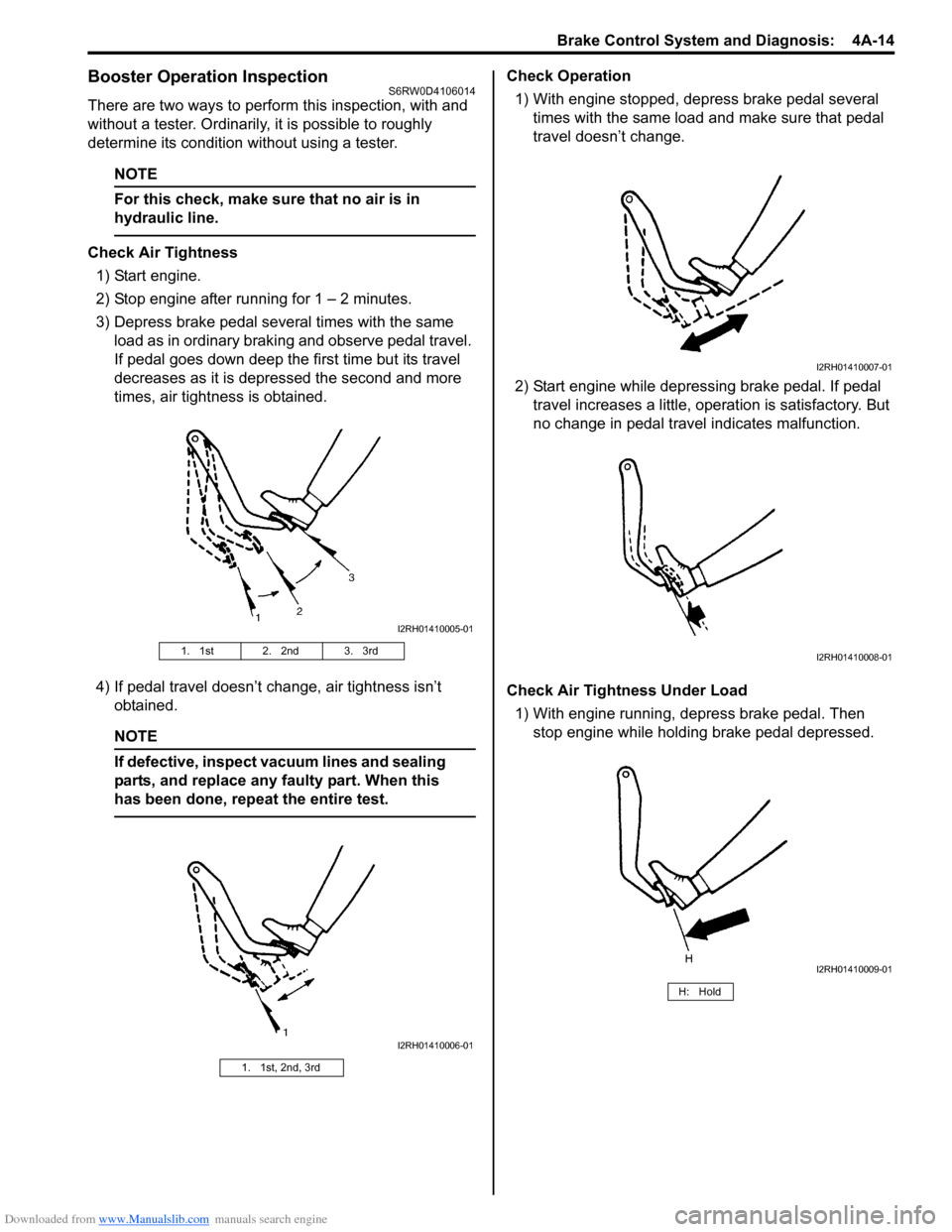
Downloaded from www.Manualslib.com manuals search engine Brake Control System and Diagnosis: 4A-14
Booster Operation InspectionS6RW0D4106014
There are two ways to perform this inspection, with and
without a tester. Ordinarily, it is possible to roughly
determine its condition without using a tester.
NOTE
For this check, make sure that no air is in
hydraulic line.
Check Air Tightness
1) Start engine.
2) Stop engine after running for 1 – 2 minutes.
3) Depress brake pedal several times with the same
load as in ordinary braking and observe pedal travel.
If pedal goes down deep the first time but its travel
decreases as it is depressed the second and more
times, air tightness is obtained.
4) If pedal travel doesn’t change, air tightness isn’t
obtained.
NOTE
If defective, inspect vacuum lines and sealing
parts, and replace any faulty part. When this
has been done, repeat the entire test.
Check Operation
1) With engine stopped, depress brake pedal several
times with the same load and make sure that pedal
travel doesn’t change.
2) Start engine while depressing brake pedal. If pedal
travel increases a little, operation is satisfactory. But
no change in pedal travel indicates malfunction.
Check Air Tightness Under Load
1) With engine running, depress brake pedal. Then
stop engine while holding brake pedal depressed.
1. 1st 2. 2nd 3. 3rd
1. 1st, 2nd, 3rd
I2RH01410005-01
I2RH01410006-01
H: Hold
I2RH01410007-01
I2RH01410008-01
I2RH01410009-01
Page 586 of 1556
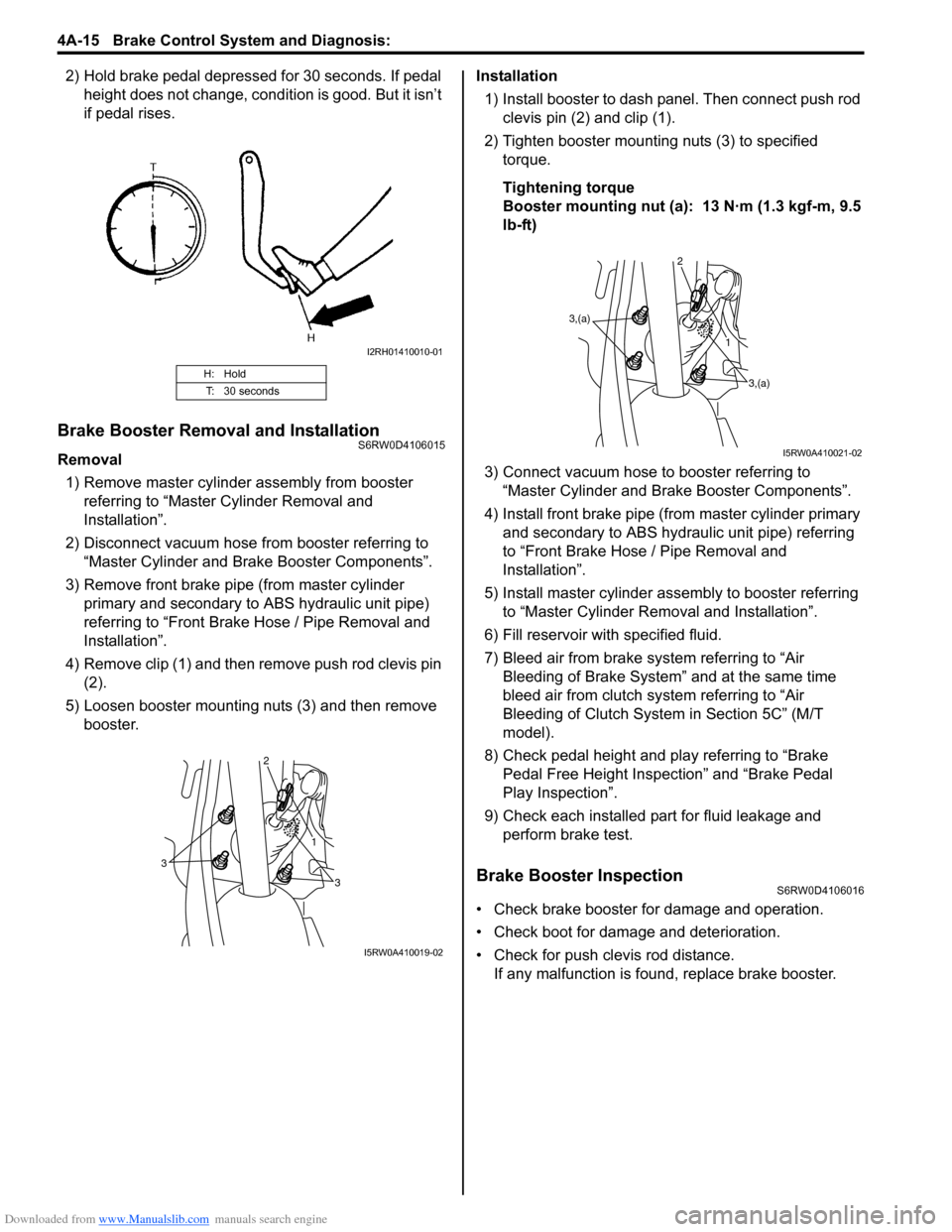
Downloaded from www.Manualslib.com manuals search engine 4A-15 Brake Control System and Diagnosis:
2) Hold brake pedal depressed for 30 seconds. If pedal
height does not change, condition is good. But it isn’t
if pedal rises.
Brake Booster Removal and InstallationS6RW0D4106015
Removal
1) Remove master cylinder assembly from booster
referring to “Master Cylinder Removal and
Installation”.
2) Disconnect vacuum hose from booster referring to
“Master Cylinder and Brake Booster Components”.
3) Remove front brake pipe (from master cylinder
primary and secondary to ABS hydraulic unit pipe)
referring to “Front Brake Hose / Pipe Removal and
Installation”.
4) Remove clip (1) and then remove push rod clevis pin
(2).
5) Loosen booster mounting nuts (3) and then remove
booster.Installation
1) Install booster to dash panel. Then connect push rod
clevis pin (2) and clip (1).
2) Tighten booster mounting nuts (3) to specified
torque.
Tightening torque
Booster mounting nut (a): 13 N·m (1.3 kgf-m, 9.5
lb-ft)
3) Connect vacuum hose to booster referring to
“Master Cylinder and Brake Booster Components”.
4) Install front brake pipe (from master cylinder primary
and secondary to ABS hydraulic unit pipe) referring
to “Front Brake Hose / Pipe Removal and
Installation”.
5) Install master cylinder assembly to booster referring
to “Master Cylinder Removal and Installation”.
6) Fill reservoir with specified fluid.
7) Bleed air from brake system referring to “Air
Bleeding of Brake System” and at the same time
bleed air from clutch system referring to “Air
Bleeding of Clutch System in Section 5C” (M/T
model).
8) Check pedal height and play referring to “Brake
Pedal Free Height Inspection” and “Brake Pedal
Play Inspection”.
9) Check each installed part for fluid leakage and
perform brake test.
Brake Booster InspectionS6RW0D4106016
• Check brake booster for damage and operation.
• Check boot for damage and deterioration.
• Check for push clevis rod distance.
If any malfunction is found, replace brake booster.
H: Hold
T: 30 seconds
I2RH01410010-01
3
3 1 2
I5RW0A410019-02
3,(a)
3,(a) 1 2
I5RW0A410021-02
Page 587 of 1556
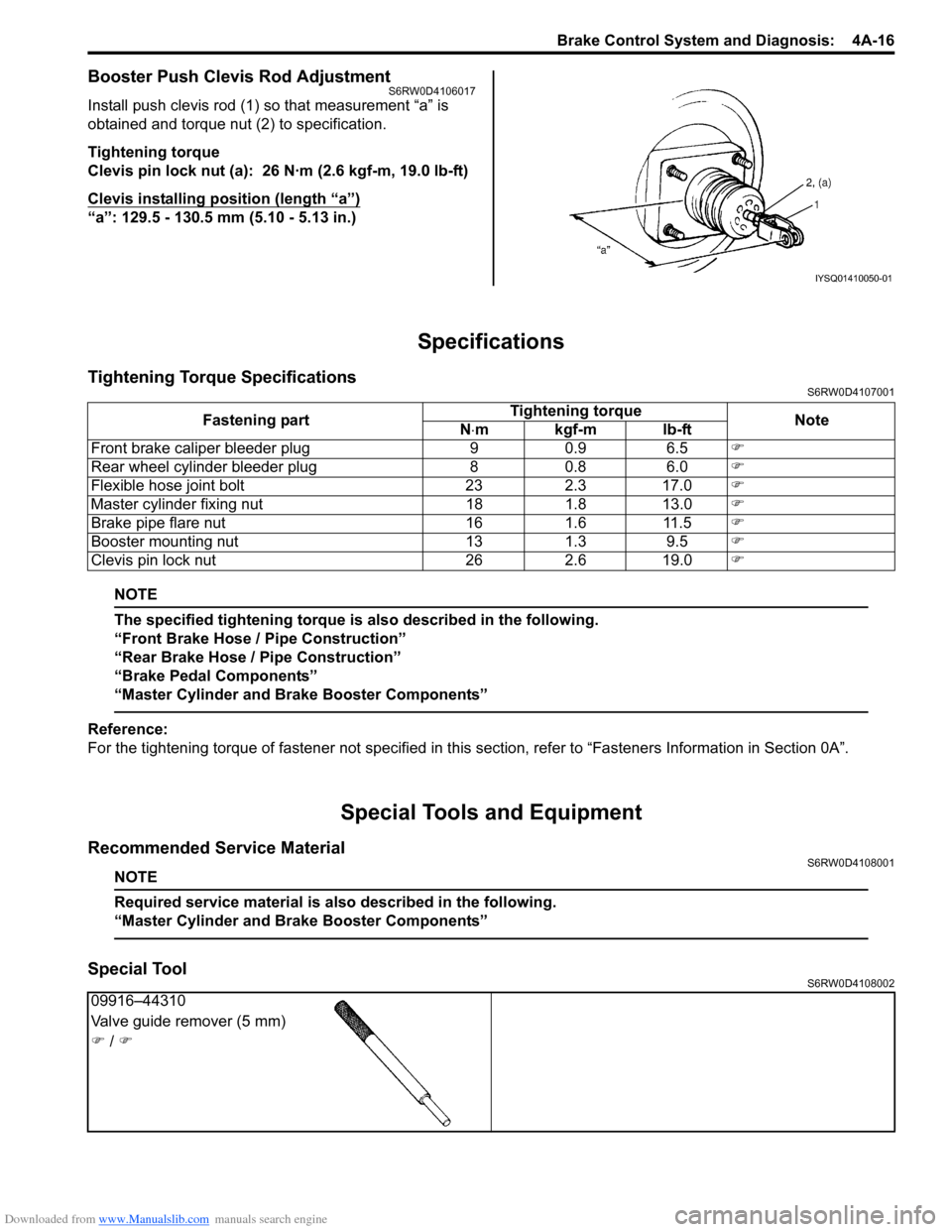
Downloaded from www.Manualslib.com manuals search engine Brake Control System and Diagnosis: 4A-16
Booster Push Clevis Rod AdjustmentS6RW0D4106017
Install push clevis rod (1) so that measurement “a” is
obtained and torque nut (2) to specification.
Tightening torque
Clevis pin lock nut (a): 26 N·m (2.6 kgf-m, 19.0 lb-ft)
Clevis installing position (length “a”)
“a”: 129.5 - 130.5 mm (5.10 - 5.13 in.)
Specifications
Tightening Torque SpecificationsS6RW0D4107001
NOTE
The specified tightening torque is also described in the following.
“Front Brake Hose / Pipe Construction”
“Rear Brake Hose / Pipe Construction”
“Brake Pedal Components”
“Master Cylinder and Brake Booster Components”
Reference:
For the tightening torque of fastener not specified in this section, refer to “Fasteners Information in Section 0A”.
Special Tools and Equipment
Recommended Service MaterialS6RW0D4108001
NOTE
Required service material is also described in the following.
“Master Cylinder and Brake Booster Components”
Special ToolS6RW0D4108002
IYSQ01410050-01
Fastening partTightening torque
Note
N⋅mkgf-mlb-ft
Front brake caliper bleeder plug 9 0.9 6.5�)
Rear wheel cylinder bleeder plug 8 0.8 6.0�)
Flexible hose joint bolt 23 2.3 17.0�)
Master cylinder fixing nut 18 1.8 13.0�)
Brake pipe flare nut 16 1.6 11.5�)
Booster mounting nut 13 1.3 9.5�)
Clevis pin lock nut 26 2.6 19.0�)
09916–44310
Valve guide remover (5 mm)
�) / �)
Page 588 of 1556
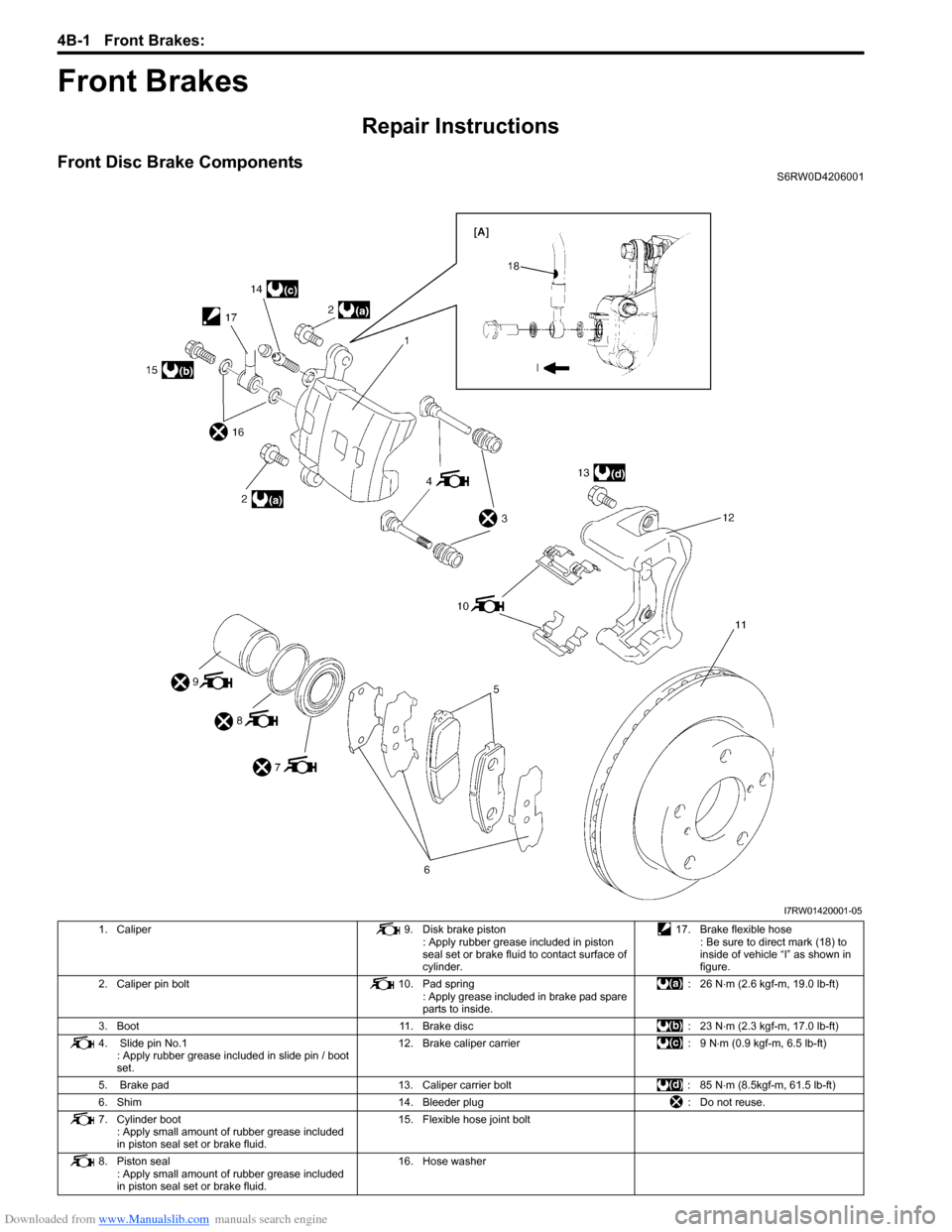
Downloaded from www.Manualslib.com manuals search engine 4B-1 Front Brakes:
Brakes
Front Brakes
Repair Instructions
Front Disc Brake ComponentsS6RW0D4206001
I7RW01420001-05
1. Caliper 9. Disk brake piston
: Apply rubber grease included in piston
seal set or brake fluid to contact surface of
cylinder.17. Brake flexible hose
: Be sure to direct mark (18) to
inside of vehicle “I” as shown in
figure.
2. Caliper pin bolt 10. Pad spring
: Apply grease included in brake pad spare
parts to inside.: 26 N⋅m (2.6 kgf-m, 19.0 lb-ft)
3. Boot 11. Brake disc : 23 N⋅m (2.3 kgf-m, 17.0 lb-ft)
4. Slide pin No.1
: Apply rubber grease included in slide pin / boot
set.12. Brake caliper carrier : 9 N⋅m (0.9 kgf-m, 6.5 lb-ft)
5. Brake pad 13. Caliper carrier bolt : 85 N⋅m (8.5kgf-m, 61.5 lb-ft)
6. Shim 14. Bleeder plug : Do not reuse.
7. Cylinder boot
: Apply small amount of rubber grease included
in piston seal set or brake fluid.15. Flexible hose joint bolt
8. Piston seal
: Apply small amount of rubber grease included
in piston seal set or brake fluid.16. Hose washer
Page 589 of 1556
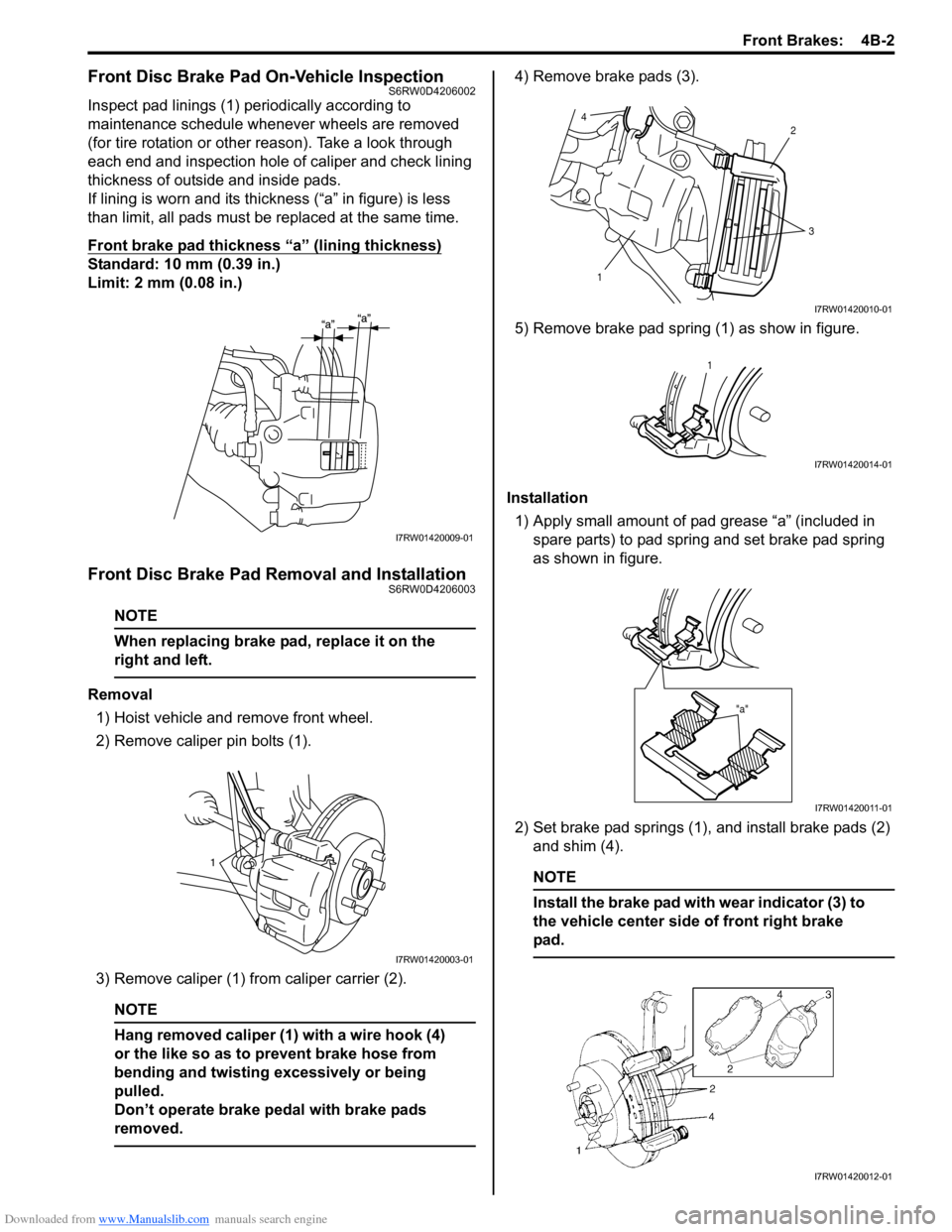
Downloaded from www.Manualslib.com manuals search engine Front Brakes: 4B-2
Front Disc Brake Pad On-Vehicle InspectionS6RW0D4206002
Inspect pad linings (1) periodically according to
maintenance schedule whenever wheels are removed
(for tire rotation or other reason). Take a look through
each end and inspection hole of caliper and check lining
thickness of outside and inside pads.
If lining is worn and its thickness (“a” in figure) is less
than limit, all pads must be replaced at the same time.
Front brake pad thickness “a” (lining thickness)
Standard: 10 mm (0.39 in.)
Limit: 2 mm (0.08 in.)
Front Disc Brake Pad Removal and InstallationS6RW0D4206003
NOTE
When replacing brake pad, replace it on the
right and left.
Removal
1) Hoist vehicle and remove front wheel.
2) Remove caliper pin bolts (1).
3) Remove caliper (1) from caliper carrier (2).
NOTE
Hang removed caliper (1) with a wire hook (4)
or the like so as to prevent brake hose from
bending and twisting excessively or being
pulled.
Don’t operate brake pedal with brake pads
removed.
4) Remove brake pads (3).
5) Remove brake pad spring (1) as show in figure.
Installation
1) Apply small amount of pad grease “a” (included in
spare parts) to pad spring and set brake pad spring
as shown in figure.
2) Set brake pad springs (1), and install brake pads (2)
and shim (4).
NOTE
Install the brake pad with wear indicator (3) to
the vehicle center side of front right brake
pad.
I7RW01420009-01
1
I7RW01420003-01
42
3
1
I7RW01420010-01
1
I7RW01420014-01
"a"
I7RW01420011-01
I7RW01420012-01
Page 590 of 1556
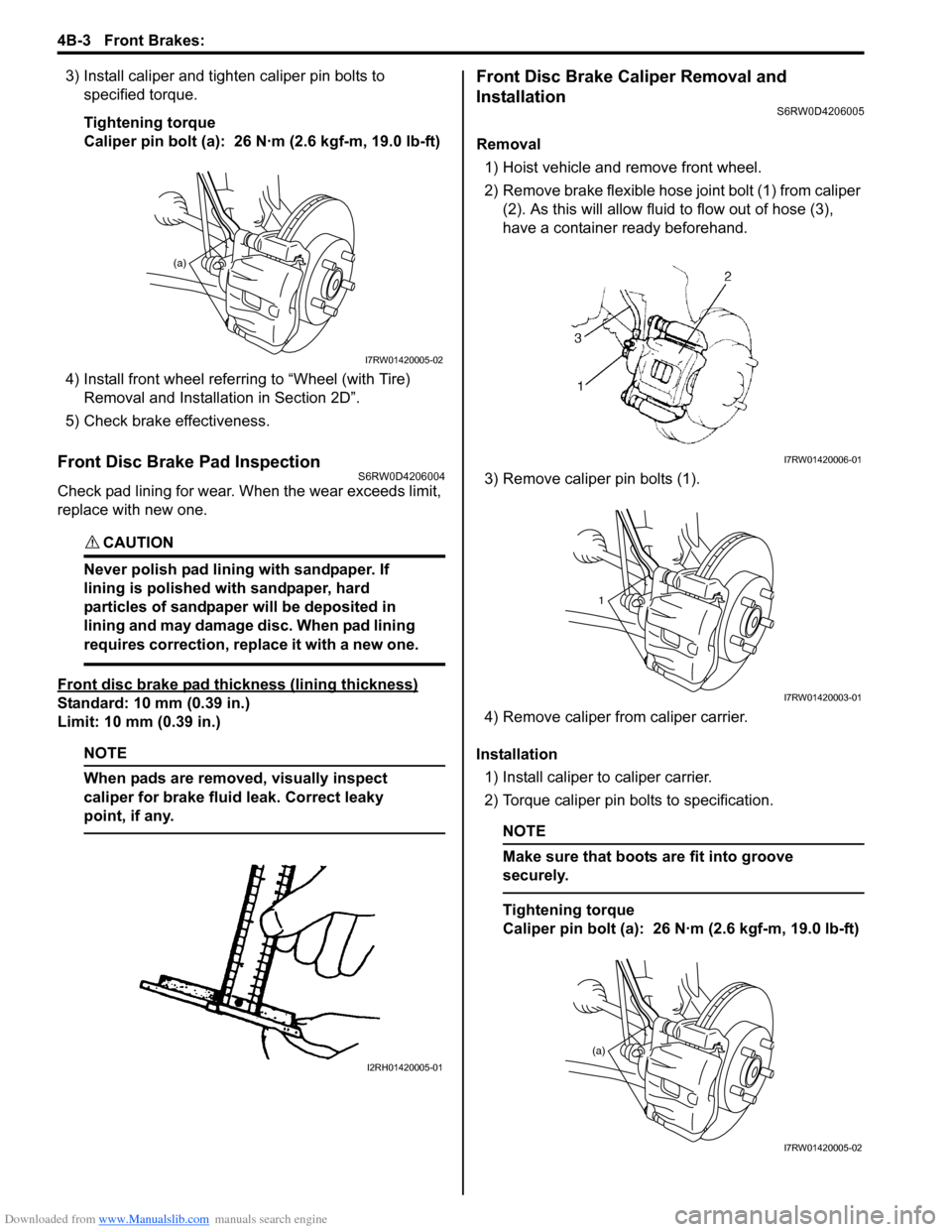
Downloaded from www.Manualslib.com manuals search engine 4B-3 Front Brakes:
3) Install caliper and tighten caliper pin bolts to
specified torque.
Tightening torque
Caliper pin bolt (a): 26 N·m (2.6 kgf-m, 19.0 lb-ft)
4) Install front wheel referring to “Wheel (with Tire)
Removal and Installation in Section 2D”.
5) Check brake effectiveness.
Front Disc Brake Pad InspectionS6RW0D4206004
Check pad lining for wear. When the wear exceeds limit,
replace with new one.
CAUTION!
Never polish pad lining with sandpaper. If
lining is polished with sandpaper, hard
particles of sandpaper will be deposited in
lining and may damage disc. When pad lining
requires correction, replace it with a new one.
Front disc brake pad thickness (lining thickness)
Standard: 10 mm (0.39 in.)
Limit: 10 mm (0.39 in.)
NOTE
When pads are removed, visually inspect
caliper for brake fluid leak. Correct leaky
point, if any.
Front Disc Brake Caliper Removal and
Installation
S6RW0D4206005
Removal
1) Hoist vehicle and remove front wheel.
2) Remove brake flexible hose joint bolt (1) from caliper
(2). As this will allow fluid to flow out of hose (3),
have a container ready beforehand.
3) Remove caliper pin bolts (1).
4) Remove caliper from caliper carrier.
Installation
1) Install caliper to caliper carrier.
2) Torque caliper pin bolts to specification.
NOTE
Make sure that boots are fit into groove
securely.
Tightening torque
Caliper pin bolt (a): 26 N·m (2.6 kgf-m, 19.0 lb-ft)
(a)
I7RW01420005-02
I2RH01420005-01
I7RW01420006-01
1
I7RW01420003-01
(a)
I7RW01420005-02